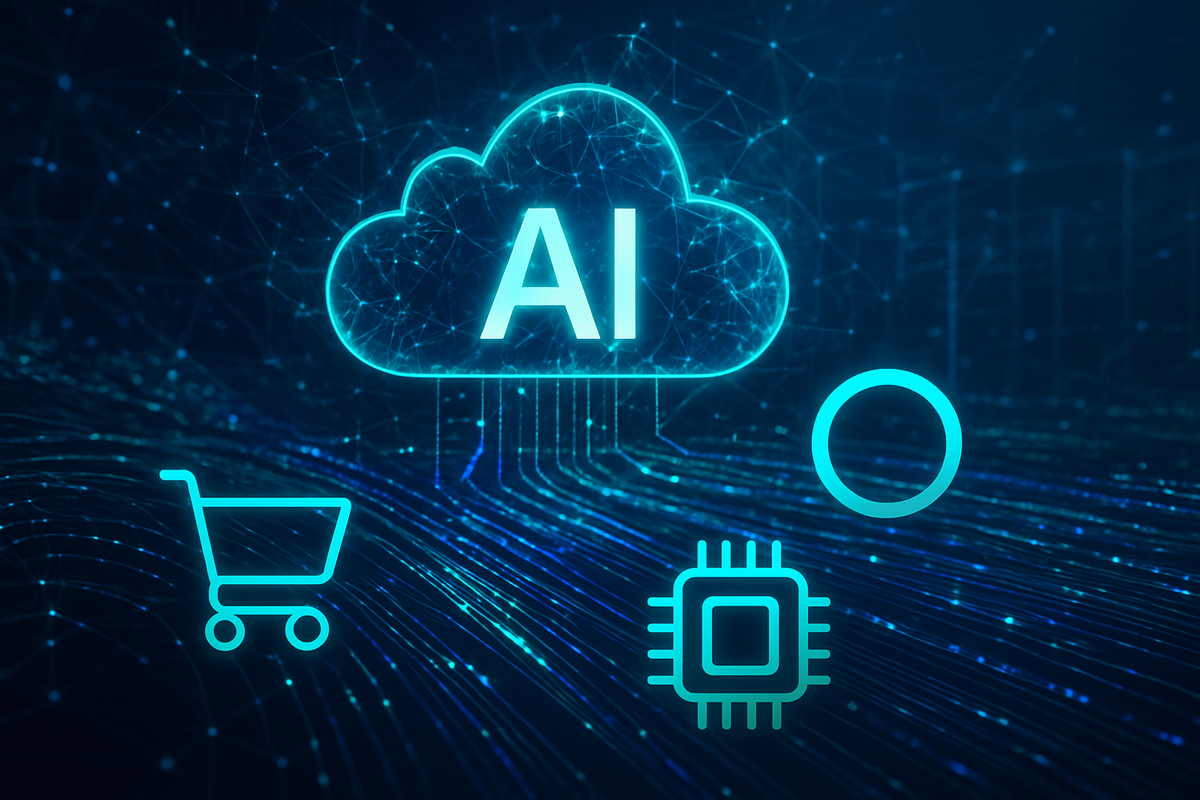
The global financial markets are buzzing with unprecedented activity as artificial intelligence (AI) rapidly integrates into every facet of commerce and technology. A flurry of strategic partnerships and massive cloud infrastructure deals, exemplified by Walmart's (NYSE: WMT) collaboration with OpenAI, Oracle's (NYSE: ORCL) aggressive AI Cloud expansion, and NVIDIA's (NASDAQ: NVDA) investment in xAI, are not merely headlines but fundamental shifts reshaping industries and driving significant capital allocation. These developments, many culminating in late 2024 and throughout 2025, underscore a fierce race to dominate the AI frontier, promising transformative efficiencies and new revenue streams, yet also raising questions about sustainability and profitability.
This intense period of innovation and investment is characterized by companies vying for a competitive edge in AI development and deployment. From enhancing customer experiences in retail to powering the next generation of AI models, these alliances are setting the stage for a new era of technological advancement. The financial implications are substantial, with billions flowing into infrastructure, research, and development, influencing stock valuations and setting new industry benchmarks. As of October 16, 2025, the market is closely watching how these intricate webs of partnerships will play out, with immediate and long-term consequences for stakeholders across the board.
Unpacking the AI Revolution's Latest Chapters
The past few months have been pivotal, witnessing several landmark announcements that highlight the accelerating pace of AI adoption and infrastructure build-out. These events are not isolated but rather interconnected components of a larger strategic push by industry giants to harness the power of AI.
On October 14, 2025, retail behemoth Walmart (NYSE: WMT) unveiled a groundbreaking partnership with OpenAI, integrating shopping directly into ChatGPT with an "Instant Checkout" feature. This collaboration aims to revolutionize online retail, allowing customers to use natural language prompts to discover products and complete purchases seamlessly, bypassing traditional search methods. The integration extends to existing Walmart and Sam's Club accounts, streamlining the entire shopping experience. The announcement sent Walmart's stock soaring by nearly 5% to a record high of $107.21 on October 14, adding approximately $50 billion to its market capitalization. Analysts at Morgan Stanley project this partnership could boost Walmart's EBIT margin by up to 40%, reflecting strong investor confidence in its digital strategy. For OpenAI, this deal is expected to significantly increase revenue, demonstrating the tangible economic returns of its AI investments and potentially reducing its reliance on debt funding.
Meanwhile, Oracle (NYSE: ORCL) has been making an aggressive foray into the AI cloud market, marked by substantial investments and strategic alliances. In September 2025, Oracle reported a significant increase in its remaining performance obligations (RPO) to $455 billion, primarily driven by multi-billion dollar AI contracts. A cornerstone of this strategy is the "Stargate Project," a colossal $500 billion initiative launched in January 2025 by Oracle, OpenAI, Microsoft (NASDAQ: MSFT), and NVIDIA (NASDAQ: NVDA) to build 20 AI data centers across the U.S. over four years. In July 2025, Oracle and OpenAI formalized a $300 billion, five-year agreement for Oracle to serve as a critical infrastructure provider for OpenAI's demanding AI workloads. Oracle has also deepened its alliance with NVIDIA, deploying one of the world's largest AI SuperComputers equipped with up to 65,000 NVIDIA H200 GPUs and integrating NVIDIA's AI Enterprise software directly into Oracle Cloud Infrastructure (OCI). In a move signaling broader diversification, on October 14, 2025, Oracle announced a partnership with AMD (NASDAQ: AMD) to deploy 50,000 AMD Instinct MI450 Series GPUs on OCI, with initial deployment slated for Q3 2026, offering customers expanded choice in chip solutions. However, investor sentiment saw a shift on October 7, 2025, when reports revealed that Oracle's AI cloud business, particularly the rental of NVIDIA-powered servers, was operating with surprisingly thin gross profit margins of 14%, a stark contrast to its traditional software business's 70% margins. This news caused Oracle's shares to drop by as much as 7.1% on the NYSE, sparking concerns about the profitability of the capital-intensive AI infrastructure race.
Adding to the dynamic landscape, NVIDIA (NASDAQ: NVDA) CEO Jensen Huang confirmed a strategic investment of $200 million in Elon Musk's AI startup, xAI, in October 2025. This investment is part of xAI's broader $2 billion fundraising effort, aimed at securing priority access to NVIDIA's highly sought-after GPUs. Under the agreement, NVIDIA will supply and retain ownership of GPUs deployed in xAI's upcoming "Colossus 2" data center, which xAI will then rent for five years. xAI plans to raise up to $20 billion to scale its infrastructure to 200,000 NVIDIA Blackwell GPUs. This innovative financial structure, involving a special purpose vehicle (SPV), ensures a steady, long-term demand for NVIDIA's GPUs and strengthens its position within the generative AI ecosystem. While a positive catalyst, NVIDIA's stock experienced a slight dip on October 15, 2025, following Oracle's announcement of its partnership with AMD, signaling increasing competition in the AI chip market.
Beyond these high-profile examples, the AI infrastructure race is attracting massive capital from diverse players. On October 16, 2025, a consortium led by BlackRock's (NYSE: BLK) Global Infrastructure Partners (GIP), alongside Abu Dhabi’s MGX and the Artificial Intelligence Infrastructure Partnership (AIP)—which includes NVIDIA and Microsoft (NASDAQ: MSFT)—agreed to acquire Aligned Data Centers for approximately $40 billion. This marks AIP’s first major investment, with plans for an initial $30 billion in equity, potentially reaching $100 billion with debt financing, to fuel AI infrastructure development. Similarly, on October 15, 2025, Arm Holdings (NASDAQ: ARM) and Meta Platforms (NASDAQ: META) deepened their multi-year collaboration to enhance AI efficiency across various computing layers, optimizing AI software within frameworks like PyTorch and ExecuTorch. Furthermore, Brookfield (NYSE: BN) and Bloom Energy (NYSE: BE) unveiled a $5 billion strategic partnership on October 13, 2025, to develop "AI factories" powered by Bloom's fuel cell technology, addressing the substantial power demands and existing grid limitations.
Who Stands to Gain (or Lose) in the AI Gold Rush?
The intense wave of AI partnerships and cloud deals is creating clear winners and losers, reshaping competitive landscapes and investment opportunities across various sectors.
On the winning side, companies that are either providing the foundational infrastructure for AI or strategically integrating AI into their core operations are poised for significant growth. NVIDIA (NASDAQ: NVDA) remains a dominant force, with its GPUs being the backbone of virtually every major AI initiative. Its investment in xAI and deep alliances with Oracle and Microsoft ensure continued demand for its high-performance chips, solidifying its market leadership. Oracle (NYSE: ORCL), despite recent concerns over thin AI cloud margins, is rapidly expanding its cloud infrastructure, securing massive multi-billion dollar contracts, and diversifying its chip suppliers with AMD (NASDAQ: AMD). This aggressive strategy positions Oracle as a critical player in the AI infrastructure game, even if initial profitability requires careful management. AMD (NASDAQ: AMD), through its partnership with Oracle, is gaining significant traction in the high-performance computing market, challenging NVIDIA's dominance and offering customers more choice, which could lead to substantial revenue growth.
Retail giants like Walmart (NYSE: WMT) are demonstrating how AI can directly translate into enhanced customer experience and increased market share. Their partnership with OpenAI is a prime example of a legacy company leveraging cutting-edge AI to innovate its core business, potentially boosting its EBIT margins significantly. OpenAI, as a leading AI model developer, is clearly a major beneficiary, securing substantial revenue through partnerships like the one with Walmart and infrastructure agreements with Oracle, validating the commercial viability of its advanced AI.
Other significant winners include infrastructure providers and investors. The BlackRock (NYSE: BLK)-led consortium acquiring Aligned Data Centers, along with Microsoft (NASDAQ: MSFT) and NVIDIA (NASDAQ: NVDA) as part of AIP, highlights the escalating value of AI-ready data centers. Brookfield (NYSE: BN) and Bloom Energy (NYSE: BE) are capitalizing on the massive energy demands of AI factories, positioning Bloom's fuel cell technology as a crucial solution for sustainable and scalable power. Arm Holdings (NASDAQ: ARM) continues to benefit from its foundational role in chip design, with its collaboration with Meta Platforms (NASDAQ: META) showcasing its importance in optimizing AI efficiency from edge to cloud.
On the flip side, potential losers include companies that fail to adapt quickly to AI integration or cannot keep pace with the massive capital expenditures required to build and maintain competitive AI infrastructure. Traditional businesses that ignore the transformative power of AI risk being outmaneuvered by more agile, AI-driven competitors. Smaller cloud providers or those with less advanced infrastructure may struggle to compete with the scale and specialized offerings of giants like Oracle, Microsoft (NASDAQ: MSFT), and Amazon Web Services (NASDAQ: AMZN). Furthermore, companies solely focused on short-term profits in the AI infrastructure space, without a clear long-term strategy for efficiency and scale, might face challenges, as highlighted by Oracle's initial thin AI cloud margins. The intense competition among chip manufacturers could also put pressure on pricing and margins for those who cannot innovate fast enough.
The Broader AI Horizon: Trends, Ripples, and Regulatory Glances
These recent partnerships and deals are more than isolated events; they are critical manifestations of broader industry trends signaling a profound shift in how technology and business intersect. The overarching theme is an accelerated "AI infrastructure race," where companies are pouring massive capital into building the computational and data center backbone necessary to power increasingly complex AI models. This trend is not confined to tech companies; it's permeating traditional sectors like retail, as demonstrated by Walmart (NYSE: WMT), illustrating AI's potential to revolutionize operations and customer engagement across the economy.
The ripple effects of this intense investment are extensive. There's an unprecedented demand for high-performance computing components, particularly GPUs from NVIDIA (NASDAQ: NVDA) and increasingly AMD (NASDAQ: AMD), putting pressure on global supply chains. The construction and operation of vast AI data centers are driving a surge in demand for land, energy, and specialized cooling technologies, leading to partnerships like Brookfield (NYSE: BN) and Bloom Energy (NYSE: BE) addressing power solutions. This also creates opportunities for real estate and construction firms specializing in data center development. The financial services sector, for instance, is projected to generate $1.2 trillion in value from AI by 2035, with spending on AI in finance expected to reach $26.67 billion by 2025, underscoring the transformative potential across industries.
While the immediate focus is on growth and innovation, the escalating scale of these AI operations also brings potential regulatory and policy implications into sharper focus. Concerns around market concentration, data privacy, and the ethical use of powerful AI models are likely to attract increased scrutiny from governments worldwide. The sheer amount of data required to train these models, and the potential for a few dominant players to control this critical infrastructure, could lead to calls for antitrust reviews and new regulations to ensure fair competition and protect consumer interests.
Historically, this period draws comparisons to the internet boom of the late 1990s. The rapid pace of technological advancement, massive capital inflows, and soaring valuations have led some on Wall Street to vocalize concerns about a potential "AI bubble." Goldman Sachs reported that AI-related corporate credit issuance has already hit $141 billion this year, surpassing last year's total, indicating a substantial increase in debt financing fueling AI growth. While the long-term potential of AI is undeniable, the sustainability of profitability, especially in the capital-intensive infrastructure sector as highlighted by Oracle's (NYSE: ORCL) thin AI cloud margins, remains a key consideration that differentiates this era from past tech booms and busts. The current date of October 16, 2025, places us firmly in the midst of this dynamic period, where the long-term implications are still unfolding.
The Road Ahead: Navigating the AI Frontier
Looking forward, the landscape of AI partnerships and cloud deals is set for continued rapid evolution, presenting both immense opportunities and significant challenges for businesses and investors alike.
In the short-term, we can expect to see an intensification of the AI infrastructure build-out. Companies like Oracle (NYSE: ORCL), Microsoft (NASDAQ: MSFT), and Alphabet (NASDAQ: GOOGL) will continue to invest billions in expanding their cloud and data center capacities, driven by the insatiable demand for computational power from AI developers like OpenAI and xAI. The competition among chip manufacturers, particularly NVIDIA (NASDAQ: NVDA) and AMD (NASDAQ: AMD), will likely heat up further, leading to faster innovation cycles and potentially more diverse offerings in the market. We will also see more traditional enterprises, inspired by Walmart's (NYSE: WMT) move, exploring and announcing strategic AI integrations to enhance their operations and customer touchpoints.
The long-term possibilities are even more profound. As AI models become more sophisticated and widely adopted, they will drive fundamental transformations across virtually every industry, from healthcare and finance to manufacturing and logistics. This will necessitate strategic pivots for many companies, requiring them to integrate AI into their core business models, workforce training, and product development cycles. New market opportunities will emerge in specialized AI services, ethical AI development, and advanced energy solutions for AI data centers. However, challenges will also arise, including the immense capital requirements, the scarcity of specialized AI talent, and the increasing complexity of managing vast AI ecosystems.
Potential scenarios and outcomes include a continued period of sustained growth and innovation, leading to significant economic expansion driven by AI. Alternatively, if the profitability of AI infrastructure remains thin and investment outpaces tangible returns, there could be a market correction or consolidation among cloud providers. Regulatory bodies are also likely to become more active, potentially shaping the development and deployment of AI through new policies on data governance, algorithmic transparency, and market competition. The ability of companies to adapt to these evolving technological, economic, and regulatory landscapes will determine their success in the coming years.
Wrapping Up: A Market Transformed by Intelligence
The current wave of major AI partnerships and cloud deals represents a pivotal moment in technological history, characterized by an unprecedented scale of investment and strategic collaboration. From Walmart's (NYSE: WMT) innovative integration with OpenAI to Oracle's (NYSE: ORCL) aggressive cloud expansion and NVIDIA's (NASDAQ: NVDA) strategic backing of xAI, these developments are not just about technology; they are about fundamentally reshaping industries, creating new economic value, and redefining competitive advantages.
The key takeaway is the relentless pursuit of AI dominance, driving a massive allocation of capital into infrastructure and R&D. While the promise of AI-driven efficiencies and new revenue streams is immense, the market is also grappling with the realities of this capital-intensive race. Concerns about an "AI bubble," fueled by soaring valuations and significant debt issuance, alongside questions about the profitability of AI cloud services, underscore the dual nature of this opportunity.
Moving forward, investors should closely watch several critical indicators. The sustainability of profit margins in the AI infrastructure sector, particularly for cloud providers, will be a crucial factor. Continued innovation and diversification in AI chip development, as evidenced by Oracle's (NYSE: ORCL) partnership with AMD (NASDAQ: AMD), will be vital for maintaining competition and driving efficiency. Furthermore, the ability of companies to translate AI investments into tangible, measurable business outcomes—whether through enhanced customer experiences, operational cost savings, or entirely new product offerings—will ultimately determine their long-term success. The market is in a state of dynamic transformation, and only those who can strategically navigate its complexities will truly thrive in this new era of artificial intelligence.
This content is intended for informational purposes only and is not financial advice






